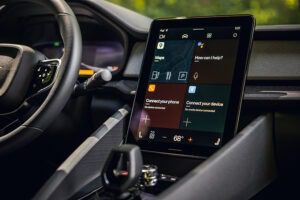 SAN DIEGO — I drive a lot of different cars which means I use a lot of different infotainment units. These are the in-dash screens that control things like the radio, climate control, and wide variety of connectivity and “apps” that carmakers are looking to stuff into their cars these days.
SAN DIEGO — I drive a lot of different cars which means I use a lot of different infotainment units. These are the in-dash screens that control things like the radio, climate control, and wide variety of connectivity and “apps” that carmakers are looking to stuff into their cars these days.
Some of them are ok, some of them are meh, and some of them are really bad. None of them are great, which is why I’m always emphasizing when cars support Apple CarPlay or Android Auto. With those technologies, the in-car experience is handed over to your smartphone. This is a good thing because you use your smartphone a lot and it has literally billions of dollars invested in making the user experience a good one.
Apple and Google are really good at user interface design, and each have more than a billion users and a lot of feedback to go on when improving things.
Car companies don’t have the billions of dollars to spend on UX, and have a lot of other difficulties like ensuring their systems can last for more than a decade and run reliably no matter what. This isn’t to rag on car companies — your iPhone will be obsolete in three or four years, while that new F-150 you buy next week will need to last at least 20.
But it also makes you wonder why those tech companies don’t just make an in-car infotainment system. Well, now they have. The Polestar 2 is the first car to run Google’s Android Automotive operating system. It’s a special version of Android (like the system in all those smartphones) specifically designed for cars.
It has a ton of Google features built in, including Google Maps, Google Assistant and the Google Play Store, with apps specifically built for the car. It’s always connected and extremely fast and responsive. There’s an 11-inch touch display that’s the focal point of the interior, with a screen split into quadrants to give at-a-glance access to the maps, media, phone, and vehicle functions.
You can say “Hey Google” to get directions to someplace or adjust in-car functions like the climate control or seat heaters. There are apps you can download like Spotify or IHeartRadio that operate over the in-vehicle cellular connection, and more are on the way.
If you get directions, you get Google Maps point-of-interest search and if you search for something on your phone, it’ll appear in your car as well if you’re logged in to your Google account in both places.
There will also be over-the-air updates so your car can get upgrades and new features just like your phone does. Google and Polestar worked together for three years to make this system a reality, and it’ll be coming to more vehicles as carmakers realize it’s easier to outsource this to Google than it is to invent their own, inferior system.
Google Maps is particularly excellent, as it takes over the dash screen as well to show you upcoming turns in a crisp, clear way — and the car is clever enough to tell you what your estimated battery level will be when you get to your destination, and to suggest potential charging locations on the way. Apple CarPlay support is coming later this year, so if you want to skip all the Google nonsense and just use your phone, you can do that too.
This system is also in the new Volvo XC40 Recharge EV, and is coming to the rest of the Volvo lineup over the next few years. Now we just need to get Android Automotive into every other car on the market.



